|
|
|
 |
 |

 |
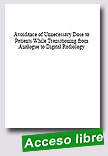 |
Avoidance of Unnecessary Dose to Patients While Transitioning from Analogue to Digital Radiology
IAEA TECDOC, 2012, 99 p.
This publication reports on the outcome of an IAEA coordinated research project and addresses the important issue of radiation dose management during the transition from analogue to digital radiology. While the radiation dose needed to obtain image quality similar to conventional imaging is lower, the latitude of the digital systems also allows much higher doses to be delivered without being detected. Recommendations on how to |
ensure that the benefit to be gained from this technology will not be outweighed by radiation risk are discussed in detail. The findings described in this publication will help both the medical community and the equipment manufacturers/suppliers make their respective contributions to dose reduction and thus optimize radiological protection of patients undergoing medical exposure.
Extraído de:
http://www-pub.iaea.org/books/IAEABooks/8197/Avoidance-of-Unnecessary-
Dose-to-Patients-While-Transitioning-from-Analogue-to-Digital-Radiology
|
 |
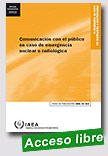 |
Comunicación con el Público en Caso de Emergencia Nuclear o Radiológica
OIEA, Abril de 2013, 118 p.
El objetivo de la presente publicación es proporcionar orientación práctica a los encargados de mantener informados al público y a los medios de comunicación, así como de coordinar todas las fuentes de información oficial, con el fin de garantizar que se transmita un mensaje coherente al público antes, durante y después de una emergencia radiológica.
Para cumplir este objetivo, la presente publicación: describe la |
forma de prepararse y obtener capacitación sobre comunicaciones en caso de emergencia antes de que se produzca una emergencia radiológica; explica la necesidad de comunicarse con el público de forma eficaz en situaciones de emergencia radiológica; y facilita principios e instrumentos de comunicación para ayudar a los OIP a comunicarse de forma eficaz durante una emergencia radiológica y a mitigar las consecuencias de la misma.
Extraído de:
http://www-pub.iaea.org/MTCD/Publications/PDF/EPR-Communications_S_web.pdf
|
 |
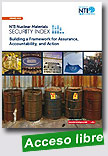 |
Nuclear Threat Initiative (NTI) Nuclear Materials Security Index
Nuclear Threat Initiative (NTI), January 2012, 128 p.
The Nuclear Threat Initiative (NTI) Nuclear Materials Security Index is a first-of-its-kind public benchmarking project of nuclear materials security conditions on a country-by-country basis. The NTI Index, prepared with the Economist Intelligence Unit (EIU), was created to spark an international discussion about priorities required to strengthen security, and most importantly, encourage governments to provide assurances and take actions to reduce risks.
|
The project draws on NTI’s nuclear expertise, the EIU’s experience in constructing indices, and the reach of the EIU’s global network of 900 analysts and contributors. NTI—working with an international panel of nuclear security experts and a number of technical advisors—focused on the framework and priorities that define effective nuclear materials security conditions. The EIU was responsible for developing the Excel-based model and gathering the data.
The NTI Index assesses the contribution of 32 states with one kilogram or more of weapons-usable nuclear materials toward improved global nuclear materials security conditions, using five categories: (a) Quantities and Sites, (b) Security and Control Measures, (c) Global Norms, (d) Domestic Commitments and Capacity, and (e) Societal Factors. An additional 144 states, with less than one kilogram of weapons-usable nuclear materials or none at all, are assessed on the last three of these categories.
The Index includes three elements: The print report, with NTI findings and recommendations, a complete discussion of the EIU methodology, and selected data; The website with high-level results in an easily accessible format, including all country summaries and interactive tools that allow visitors to determine their own priorities and weighting of categories and indicators.
A downloadable version of the NTI Index with complete results and data and extended interactive features, in an Excel format.
Extraído de: http://www.ntiindex.org/about/us/ | Site |
 |
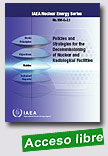 |
|
policy. The publication will be a useful guide for strategic planners, waste managers, operators of facilities under decommissioning, regulators and other stakeholders.
Extraído de: http://www-pub.iaea.org/books/IAEABooks/8659/Policies-and-Strategies-for-the-Decommissioning-of-Nuclear-and-Radiological-Facilities
|
 |
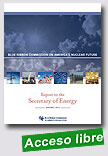 |
Blue Ribbon Commission on America’s Nuclear Future - Final Report
Blue Ribbon Commission on America’s Nuclear Future (BRC), January 2012, 180 p.
The Blue Ribbon Commission on America’s Nuclear Future (BRC) was formed by the Secretary of Energy at the request of the President to conduct a comprehensive review of policies for managing the back end of the nuclear fuel cycle and recommend a new strategy. It was cochaired by Rep. Lee H. Hamilton and Gen. Brent Scowcroft. Other Commissioners are Mr. Mark H. |
Ayers, the Hon. Vicky A. Bailey, Dr. Albert Carnesale, Sen. Pete Domenici, Ms. Susan Eisenhower, Sen. Chuck Hagel, Mr. Jonathan Lash, Dr. Allison M. Macfarlane, Dr. Richard A.
Meserve, Dr. Ernest J. Moniz, Dr. Per Peterson, Mr. John Rowe, and Rep. Phil Sharp.
The Commission and its subcommittees met more than two dozen times between March 2010 and January 2012 to hear testimony from experts and stakeholders, to visit nuclear waste management facilities in the United States and abroad, and to discuss the issues identified in its Charter. Additionally, in September and October 2011, the Commission held five public meetings, in different regions of the country, to hear feedback on its draft report. A wide variety of organizations, interest groups, and individuals provided input to the Commission at these meetings and through the submission of written materials. Copies of all of these submissions, along with records and transcripts of past meetings, are available at the BRC website (www.brc.gov).
This report highlights the Commission’s findings and conclusions and presents recommendations for consideration by the Administration and Congress, as well as interested state, tribal and local governments, other stakeholders, and the public.
Extraído de:
http://brc.gov/sites/default/files/documents/brc_finalreport_jan2012.pdf
|
 |
 |
The costs of the nuclear power sector - Thematic public report
Cour des Comptes, January 2012, 432 p.
By letter dated 17 May 2011 (Annex 1), the Prime Minister requested the Cour des Comptes, as advisor to the Government2, to report on "the costs of the nuclear power sector, including the cost of dismantling facilities and site safety", stating that he wished to "have this report before 31 January 2012". In his reply of 8 June (Annex 2), the First President stated that "given the general interest in the topic", he had "decided to |
include it in the Cour des Comptes’ programme" and specified the organizational arrangements he had made to ensure that the investigation would be carried out "pursuant to the usual procedures of the Cour des Comptes". This report is the result of that approach.
Unlike the usual work of the Cour des Comptes, the primary objective of this investigation is neither to audit accounts nor to give an opinion on the effectiveness or efficiency of energy policy. The sole objective of the report is to assess costs without commenting on their amount, which was not possible in any event within the timescale. It concentrates therefore on identifying and assessing the various costs associated with producing nuclear power in France and explaining the calculation methods and hypotheses adopted for each; the investigation
nonetheless enabled some recommendations to be made, which are to be found in the general conclusion at the end of this report.
As this report concerns only the "cost" of nuclear power production, it contains no analysis of the "price" of such electricity, or of the tariffs which finance the cost. It does not broach the increase in demand for electricity nor the energy "mix", unlike predictive analyses conducted in other forums.
Extraído de:
http://www.ccomptes.fr/content/download/43709/697228/
version/2/file/thematic_public_report_costs_nuclear_+power_
sector_012012.pdf
|
 |
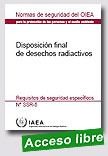
|
Disposición Final de Desechos Radiactivos
OIEA - Colección de Normas de Seguridad, 2012, 91 p.
El objetivo de esta publicación de Requisitos de Seguridad es exponer el objetivo y los criterios de seguridad para la disposición final de todo tipo de desechos radiactivos y establecer, sobre la base de los principios fijados en la
ref. [1], los requisitos que se deben satisfacer en la disposición final de desechosradiactivos.
La presente publicación de Requisitos de Seguridad está |
destinada a todas las personas que se encargan de la gestión de desechos radiactivos y de la adopción de decisiones relacionadas con el desarrollo, la explotación y el cierre de instalaciones de disposición final, sobre todo las que se ocupan de los aspectos de reglamentación conexos. Las guías de seguridad proporcionan orientaciones amplias y las mejores prácticas internacionales sobre el cumplimiento de los requisitos relativos a los distintos tipos de instalaciones de disposición final.
Extraído de: http://www-pub.iaea.org/books/IAEABooks/8745/Disposal-of-Radioactive-Waste-Specific-Safety-Requirements-Spanish-Edition
|
 |
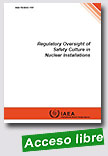 |
Regulatory Oversight of Safety Culture in Nuclear Installations
IAEA TECDOC, 2013, 48 p.
The objective of this publication is to provide regulatory bodies with practical guidance, shared experience, and examples on how to establish their own regulatory oversight of safety culture.
Due to the nature of safety culture, the variety of nuclear installations and the different “governmental, legal and regulatory frameworks for safety” Ref. [1], several approaches are currently implemented around the world to oversee safety culture. The publication details these approaches and offers |
alternatives to regulatory bodies, pros and cons, and suggestions.
The guidance provided in this publication can be applied to the regulatory oversight of safety culture in all nuclear facilities and activities, including predisposal waste management facilities, throughout their full lifetime as well as during commissioning and decommissioning phases. It is intended to be useful to regulatory bodies, technical safety organizations or thirdparty organizations when developing and implementing approaches to oversee safety culture at any licensee’s organization.
Extraído de:
http://www-pub.iaea.org/MTCD/Publications/PDF/TE_1707_web.pdf
|
 |
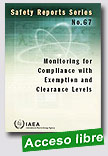 |
Monitoring for Compliance with Exemption and Clearance Levels
IAEA Safety Reports Series, 2012, 186 p.
Radioactive material is present in the environment and is also generated during the operation and subsequent decommissioning of facilities that have used or produced radioactive material. Particularly during decommissioning, a large amount of material may be generated that is below the activity limits requiring regulatory control. This Safety Report focuses on the development and practical implementation of
|
.strategies for demonstrating compliance with the established exemption and clearance levels. It provides valuable information for operators, regulatory bodies and other organizations that are involved in the monitoring of material for its release from regulatory control.
Extraído de:
http://www-pub.iaea.org/books/IAEABooks/8645/Monitoring-for-Compliance-with-Exemption-and-Clearance-Levels
|
 |
|
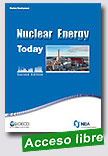
|
Nuclear Energy Today - Second Edition
Nuclear Energy Agency (NEA), 21/12/2012, 120 p.
Meeting the growing demand for energy, and electricity in particular, while addressing the need to curb greenhouse gas emissions and to ensure security of energy supply, is one of the most difficult challenges facing the world’s economies. No single technology can respond to this challenge, and the solution which policy-makers are seeking lies in the diversification of energy sources.
Although nuclear energy currently provides over 20% of electricity
|
in the OECD area and does not emit any carbon dioxide during production, it continues to be seen by many as a controversial technology. Public concern remains over its safety and the management of radioactive waste, and financing such a capital-intensive technology is a complex issue. The role that nuclear power will play in the future depends on the answers to these questions, several of which are provided in this up-to-date review of the status of nuclear energy, as well as on the outcome of research and development on the nuclear fuel cycle and reactor technologies.
Extraído de: http://www.oecdnea.org/tools/publication?query=&div=
&lang=&period=6m&sort=title&filter=1#p7089 |
 |
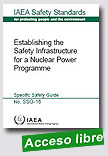 |
Establishing the Safety Infrastructure for a Nuclear Power Programme - Specific Safety Guide
IAEA Safety Standards Series, 2012, 158 p.
This Safety Guide provides guidance on the establishment of a national nuclear safety infrastructure as a key component of the overall preparations required for emerging nuclear power programmes. It provides recommendations, presented in the form of 200 sequential actions, on meeting the applicable IAEA safety requirements during the first three phases of the development of a nuclear power programme. It is intended for
|
use by persons or organizations participating in the preparation and implementation of a nuclear power programme, including government officials and legislative bodies, regulatory bodies, operating organizations and external support entities. Contents: 1. Introduction; 2. Implementing general IAEA safety requirements for establishment of the safety infrastructure; 3. Implementing the specific IAEA safety requirements for establishment of the safety infrastructure; Appendix: Overview of actions to be taken in each phase for establishment of the safety infrastructure.
Extraído de:
http://www-pub.iaea.org/books/IAEABooks/8636/Establishing-the-Safety-Infrastructure-for-a-Nuclear-Power-Programme-Specific-Safety-Guide |
 |
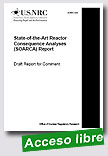 |
State-of-the-Art Reactor Consequence Analyses (SOARCA) Report - Draft Report for Comment
Nuclear Regulatory Commission, 2012, 133 p.
Accident phenomena and offsite consequences of severe reactor accidents have been the subjects of considerable research over the last several decades by the U.S. Nuclear Regulatory Commission (NRC). As a consequence of this research focus, analyses of severe accidents at nuclear power reactors are more detailed, integrated, and realistic than at any time in the past. A desire to leverage this capability to address
|
conservative aspects of previous reactor accident analyses was a major motivating factor in the genesis of the State-of-the-Art Reactor
Consequence Analyses (SOARCA) project. By applying modern analysis tools and techniques, the SOARCA project developed a body of knowledge regarding the realistic outcomes of severe nuclear reactor accidents. To accomplish this objective, the SOARCA project’s integrated modeling of accident progression and offsite consequences used both state-of-the-art computational analysis tools and best modeling practices drawn from the collective wisdom of the severe accident analysis community. This study has focused on providing a realistic evaluation of accident progression, source term, and offsite consequences for select scenarios for the Peach Bottom Atomic Power Station and Surry Power Station. By using the most current emergency preparedness practices and plant capabilities, as well as the best available modeling, these analyses are more realistic than past analyses. These analyses also consider mitigative measures (e.g., emergency operating procedures, severe accident management guidelines, and Title 10 to the Code of Federal Regulations (10 CFR) 50. 54(hh) measures), contributing to a more realistic evaluation.
Extraído de: http://adamswebsearch2.nrc.gov/webSearch2/main.jsp?
AccessionNumber='ML120250406'
|
 |
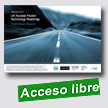 |
UK Nuclear Fission Technology Roadmap - Preliminary Report
UK National Nuclear Laboratory (NNL), February 2012, 42 p.
Without a detailed understanding of the opportunities and issues and a clear plan for maintaining and developing nuclear R&D facilities, capabilities and skills, the UK will be unable to sustain any significant increase in nuclear contribution to the low
|
carbon energy portfolio beyond 2025. Actions, if taken, can address this and help sustain the skills necessary to deliver it and secure the significant business advantage of being early to market in Europe. Any delays risk closing off options for future development and missing valuable opportunities for UK industry to capitalise on the global market.
The new build programme could greatly enhance the UK’s nuclear industry, developing its supply chain and utilising its R&D capabilities, which in turn will put it in a position to gain a share in the global nuclear renaissance. The UK nuclear energy industry infrastructure will need to expand rapidly to sustain the level of new build needed to deliver the nuclear contribution to the transition to a low carbon economy through to 2050 and beyond. The UK will require sustainable assets and processes, supply chain capability, research and development programmes, and a technology innovation and skills base to deliver the new build programme. This requires a clearly articulated vision and strategic direction.
This report sets out some of the issues that need to be addressed to keep options open for any further development of the nuclear contribution to a diverse, safe, secure and affordable energy supply portfolio to 2050 and beyond; and to maximise the UK’s take-up of the potential business opportunities offered by the growing world-wide nuclear market. Further detailed analysis of most of the issues and opportunities highlighted will be required on an early timescale to inform decisions and intervention points.
Extraído de: http://eti.co.uk/downloads/related_documents/Nuclear_
Fission_Technology_Roadmap_Feb_2012.pdf |
 |
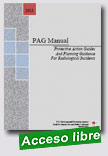 |
Protective Action Guides And Planning Guidance For Radiological Incidents
U.S. Environmental Protection Agency (EPA), March 2013, 86 p.
The U.S. Environmental Protection Agency (EPA) has developed this Manual to assist public officials in planning for emergency response to radiological incidents. For purposes of this document, a radiological incident is an event or a series of events, deliberate or accidental, leading to the release or potential release into the environment of radioactive materials in |
sufficient quantity to warrant consideration of protective actions. This Manual provides radiological protection criteria for application to all incidents that would require consideration of protective actions, with the exception of nuclear war.
Extraído de: http://www.epa.gov/radiation/docs/er/pag-manual-interim-public-comment-4-2-2013.pdf
|
| |
|
|
|
|
|
